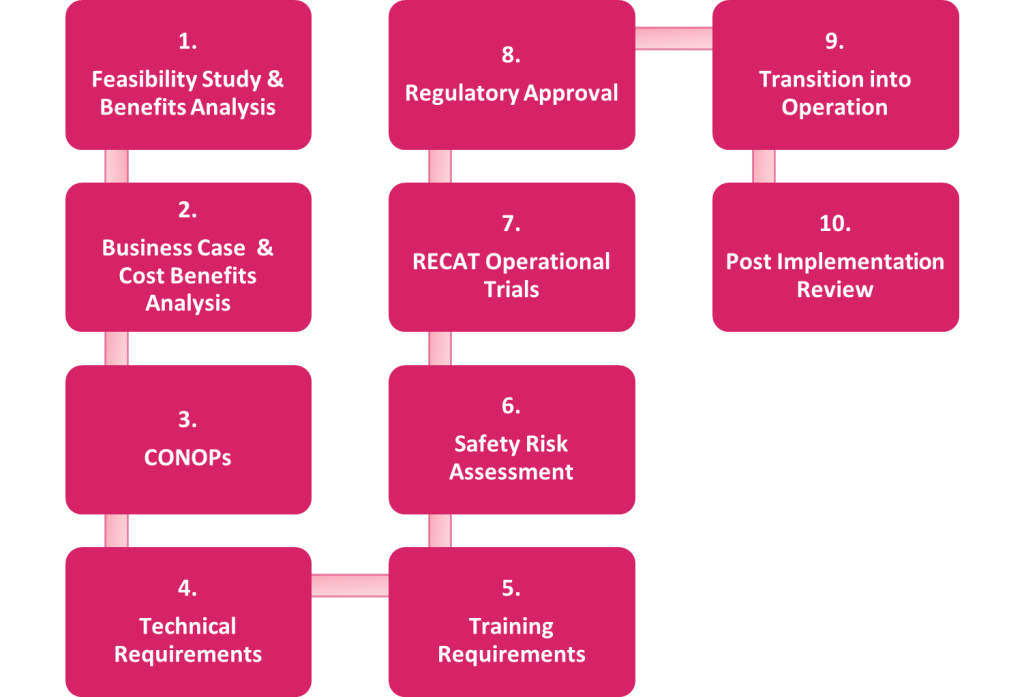 As the recovery from the COVID-19 pandemic continues, demand remains consistently high for enhanced airport capacity and efficiency, and in particular for increased runway throughput. During recent years, knowledge about wake vortex behaviour in the operational environment has increased significantly due to measured data and improved understanding of wake characteristics. This has enabled the Recategorisation of Aircraft Wake Turbulence (RECAT), which allows a reduction of aircraft separation minima, enabling optimisation of airport capacity and efficiency whilst maintaining acceptable levels of safety.
As the recovery from the COVID-19 pandemic continues, demand remains consistently high for enhanced airport capacity and efficiency, and in particular for increased runway throughput. During recent years, knowledge about wake vortex behaviour in the operational environment has increased significantly due to measured data and improved understanding of wake characteristics. This has enabled the Recategorisation of Aircraft Wake Turbulence (RECAT), which allows a reduction of aircraft separation minima, enabling optimisation of airport capacity and efficiency whilst maintaining acceptable levels of safety.
Previously the implementation of RECAT required the use of Light Detection and Ranging (LIDAR) to assess and gather data on aircraft wake behaviour in the airport and airspace environment. LIDAR assessment is an expensive, long duration, but accurate method of gathering large volumes of data on the behaviour of wake vortices (generation, dissipation and severity etc).
However, not all ANSPs can support the use of LIDAR operationally or financially, nor are they required to, as ICAO has now approved the use of Reduced Wake Turbulence Separation. Published in Amendment 9 to ICAO Doc 4444, Sixteenth Edition 2016, aircraft are sub-divided into seven wake turbulence categories as opposed to the previous four categories with published minimum separations, on both a time and distance basis, to be maintained between different aircraft categories.
In response to this, here at Think we have developed a structured, yet simplified, management of change process that will allow ANSPs to implement RECAT in a series of logical, coherent steps without the need for an expensive, long duration wake vortex assessment programme.

Our pragmatic approach does not make the assumption that RECAT is required, instead we propose, as the first step, a feasibility study and benefits analysis. This asks a simple question…”do we require RECAT or is an alternative solution preferred.”
RECAT delivers optimum benefits when there is a mixture of aircraft types and wake categories, the separation distance requirements imposed by the presence of Heavy or Super Heavy aircraft on lower category aircraft (e.g. Boeing 777 leading an Airbus A320) can be reduced through the implementation of RECAT.
Whereas, an airport operating a mostly medium aircraft schedule may not be in a position to benefit from RECAT as the separations between aircraft of a similar category are not reduced (e.g. Boeing 737 Max leader/follower pair requires 3NM separation in both standard and RECAT separations).
1. FEASIBILITY STUDY & BENEFITS ANALYSIS
Leading indicators for a requirement to deploy RECAT are increasing/excessive airborne holding times for arrivals, and increasing ground delays for departures. A validation activity, usually a Fast-Time Simulation (FTS) exercise, will model the current (commonly termed the baseline) operational environment e.g. airspace structure, Standard Instrumental Departure (SID) and Standard Terminal Arrival Route (STAR) routings, separations, runway capacity etc and produce the currently achieved capacity and throughput metrics.
This FTS will then be repeated using RECAT parameters which will deliver an accurate measurement of potential benefits in capacity and throughput from RECAT deployment. As world leaders in FTS, Think has conducted numerous RECAT feasibility studies and can leverage this experience to assist an ANSP considering the deployment of RECAT.
2. BUSINESS CASE AND COST BENEFITS ANALYSIS
Once an ANSP has decided that the implementation of RECAT is operationally feasible and that benefits can be realised from its implementation, it is recommended to create a comprehensive business case. The business case will help to prepare the required evidence for decision-makers and impacted stakeholders, on the advantages and disadvantages of the different options under consideration. Think can assist ANSPs in the preparation of their RECAT business cases.
3. CONCEPT OF OPERATIONS (CONOPs)
Although RECAT is now an ICAO approved procedure, it still requires adaptation to the specific local operational environment, ensuring that RECAT is optimally deployed in order to realise the benefits for the airport and airspace. There are many variations on a theme, some airports have only deployed RECAT for departures, some only for arrivals, and some have deployed RECAT for both modalities but only for a limited number of hours daily.
The form and function of RECAT deployed should be the one that best suits the scale and scope of the local operation, and this is described in the CONOPs, again here at Think we are positioned to assist ANSPs with the development of RECAT CONOPs.
4. TECHNICAL REQUIREMENTS
Implementation of RECAT is largely procedural, but it may require some updates to the ATM system, mainly adaptation of Flight Progress Strips (electronic or printed) to display the revised ICAO aircraft categories, and (if necessary) the Radar display to ensure that the aircraft data block displays the revised categories. At lower traffic densities it is possible to implement RECAT manually through the use of a quick-reference RECAT separation matrix by Air Traffic Controllers (ATCOs). This is an aide-de-memoire requiring ATCOs to quickly identify and implement RECAT separations between the groupings of aircraft categories, but is not generally considered to be viable at higher traffic densities.
5. TRAINING REQUIREMENTS
There is a training requirement to facilitate the introduction of RECAT. This training generally consists of limited classroom instruction supplemented by simulator training where ATCOs are coached on the application of the various RECAT wake separations. RECAT training is required for both Tower and Approach ATCOs.
6. SAFETY RISK ASSESSMENT
The deployment of RECAT requires the development of a Safety Risk Assessment to ensure that the introduction of RECAT maintains acceptable levels of safety. A key source of relevant safety data will be the historic Wake Turbulence Encounter (WTE) Occurrence Reports accumulated by the ANSP, these reports are assessed to establish wake behaviours within the local environment, along with various metrics recorded during the occurrences.
7. RECAT OPERATIONAL TRIALS
Once the historic WTE data has been analysed and interpreted, the next step is to progress into RECAT Operational Trials to gather contemporary WTE data for comparison against the historic data and to assess the changes, if any, to the current acceptable level of safety. The primary purpose of the operational trials is to gather sufficient data to populate and inform the Safety Risk Assessment.
Despite common misconceptions, the data required is not primarily concerned with RECAT separations achieved and capacity gains (although these are key components and form a large part of the benefits realisation), but rather the trials seek to gather data about WTE – the where, when, who, how and why of the WTE.
A key component of the operational trial is the development of a severity classification for WTE. There are many examples of this in use, but Think can assist in creating a WTE Severity Matrix specifically tailored to the local operations and conditions.
8. REGULATORY APPROVAL
Upon completion of the RECAT operational trials, enough data should have been gathered to populate the safety case to demonstrate that RECAT maintains acceptable levels of safety. The next step in the process is to commence the regulatory approval process to permit the formal introduction of RECAT into the functional system.
9. TRANSITION INTO OPERATION
In anticipation of Regulatory Approval for the implementation of RECAT, a transition plan should be drafted to document and monitor the transition of RECAT into operational service.
10. POST-IMPLEMENTATION REVIEW
Following the successful implementation of RECAT, it is best practice to plan and implement a process for Post Implementation Review (PIR). A comprehensive PIR process ensures that the operation of RECAT is monitored for any unforeseen reduction in acceptable levels of safety and to verify that the capacity and throughput objectives are being achieved.
At Think we are constantly striving to improve the levels of safety and productivity within the aviation industry. Hopefully this blog has given you an insight into how you can deploy RECAT in an efficient and economic way, whilst ensuring that you address safety, operational and regulatory requirements through our intuitive structured approach to the procedural implementation of RECAT.
If you are interested in the deployment of RECAT at your airport or ANSP, contact us today to find out how we can support you on this project.

Author: Paul Mullins, Principal Consultant, Think Research


Recent Comments